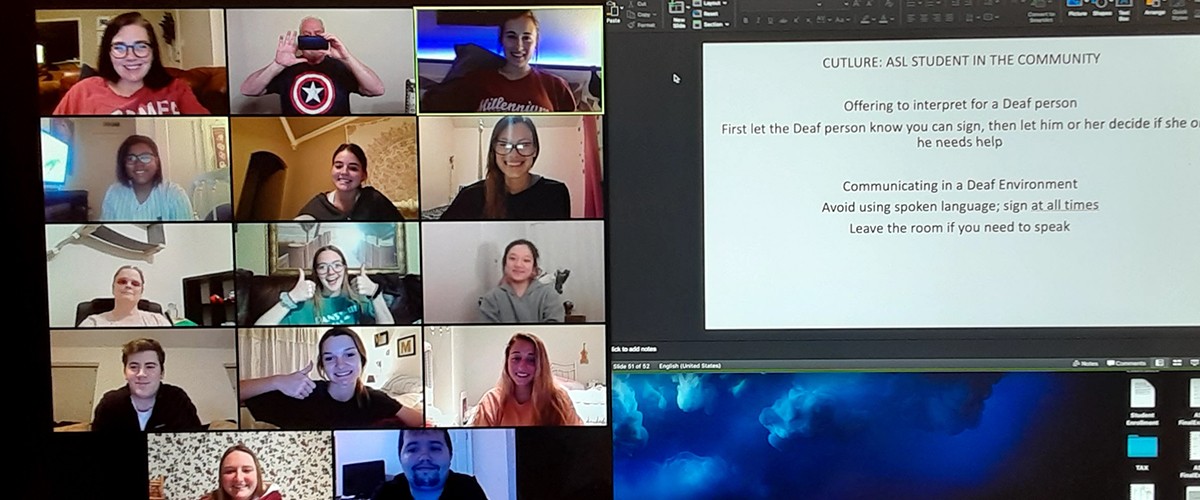
Education Moves Online
Spring is a busy time in the Jeannine Rainbolt College of Education at the University of Oklahoma. Some of our undergraduate students are in classrooms as part of their internship, preparing for graduation and their first teaching job. Many of our graduate students are taking comprehensive exams, writing and preparing to defend their theses. Faculty are teaching, mentoring and making plans for summer research projects.
But all of that came to a halt as the COVID-19 pandemic began to spread across the United States and on March 18, as students were in the middle of a social distancing spring break, it was decided that OU classes would go fully online for the rest of the semester.
Technology Needed to Make the Transition
While the decision was made on March 18, preparations were already underway in the Jeannine Rainbolt College of Education to help faculty and students make the transition. The JRCoE IT team, composed of Director of IT Ron McCarty, IT Specialist Ashton Sears and IT Support Technician Scott Davis, were hard at work make sure everyone had the tools and access they needed to conduct and take part in classroom activities from home.
“We had a Campus IT Leaders meeting prior to spring break where we discussed gearing up for campus needs in case we needed to work some from home,” McCarty said. “We started telling students who checked out a laptop before spring break they could keep the laptops until we returned from spring break. By the end of the week it looked like we would return after the break. Then, during break week, we were contacted by Dean Reeder about preparing computers for all college staff to work from home.”
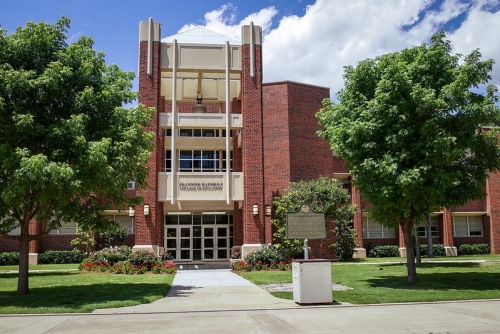
Collings Hall
“We helped a dozen students either borrow equipment, troubleshoot home wifi connection issues and answer other class participation questions,” McCarty said. “We provided laptops or items needed for using office desktops for 25 staff and also loaned and helped around 20 faculty and adjuncts on both the Norman and Tulsa campuses with needs for telecommuting.”
The college was fortunate in that several faculty were already experienced in online learning, teaching hybrid classes that blended classroom and online instruction. For those who did not have experience in that area, McCarty and his staff, as well as Director of Digital Strategy and Associate Professor Theresa Cullen and Education Technology Integration Specialist Jennifer Williams were available to answer questions and offer helpful tools for online learning.
“We have some guides that we created for Zoom that we shared with those individuals and have been offering ongoing answers to their questions as well as to provide some with webcams to use with their desktops,” McCarty said. “Not all faculty and adjuncts were issued Zoom Pro accounts, so we were able to get those assigned and help with the many changes that Zoom and the university have put into place as vulnerabilities were exposed.
“With the number of existing online and hybrid classes already being taught by the college, we were in better shape than a lot of others,” McCarty said. “Thanks to Dr. Cullen, with input from our team, a Canvas resource page was quickly developed and made available to our faculty and adjuncts with answers to many of their questions, along with tips for successful online instruction. We did not need to purchase any new software or hardware except for some adapters, cables and webcams to facilitate setting up home offices and classrooms. However, we did purchase some lecture capture software for those who want to record materials to post to Canvas for their students.
“The faculty have been overwhelming appreciative of the support available to them and have shown their appreciation in many ways."
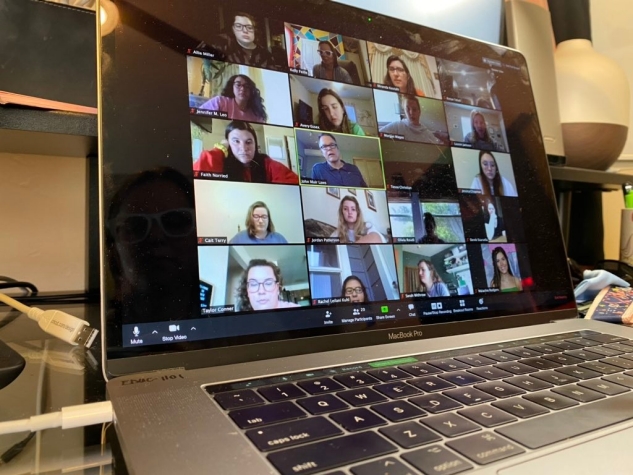
Faculty Were Tasked With Making the Teaching Transition
Science Education Assistant Professor Kelly Feille had to figure out a way to transition her hands-on Science Methods class to an online delivery. Two of the tenets that she emphasizes in the class are 1) the importance of knowing your students and nurturing a relationship with them and 2) active learning environments are important — two things that are hard to do from behind a computer screen.
“I am technologically savvy, but I still had major reservations about what ending my semester online would look like,” Feille said. “How would I maintain the relationship aspect of my mentoring and facilitation of learning about science teaching with such great distances between us? How could I help my students through some of the most difficult tasks of the semester and help them to maintain their own mental health through a global crisis? It required a pivot.”
One of the activities of the course is for students to head outdoors to allow the natural phenomena of the world to be an inspiration for learning. That turned into a project of nature journaling assignments, inspired by a new book, How to Teach Nature Journaling, from John Muir Laws and Emilie Lygren.
“These assignments are meant to push my students further into wonder, create connections between art, math, writing and science, and hopefully provide a little bit of peace during an otherwise emotionally draining time,” Feille said. “My final assignment for the semester asks students to reflect on the Wonder Journal they have kept all semester and think about the role that wonder can play in their future classroom.
“This semester doesn't look like I hoped it would. There are some holes that I don't think I will be able to fill. I miss being present with them each week engaging in the dialogue that comes so easy in person but is so stunted online. But I hope that maybe the time I ask them to spend outside – slowing down and taking it all in – will have both immediate and lasting effects on the way they experience the world. And, if my students leave the course more curious about the natural world around them and determined to share their curiosity and wonder with students, all while feeling a little bit more positive about science, then I will call it a success.”
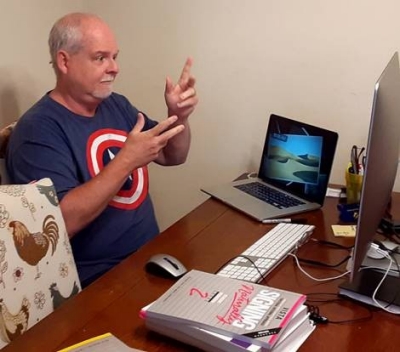
Gary Davis signs with his class over Zoom.
For American Sign Language Instructor Gary Davis, the inability to be present with his class was an even more difficult hurdle to overcome. The ASL class involves no verbal instruction and relies on breakout group work for practice of the language. In a normal setting, Davis would have his students seated in a circle where everyone could see one another.
“The hardest part of the transition has probably been the loss of face-to-face interaction,” Davis said. “I miss being able to interact with my students and having valuable face-to-face signing time.
“Zooming into class has been overwhelming. I find it hard sometimes to know who to look at, but I think we started to get a system of hand raising down, although sometimes they are confused whose turn it is. I don’t know what it is like in a hearing class, where you can listen to people, even if they talk over one another, but with signing, you really can only focus your eyes on one person at a time, and it's harder through Zoom to notice that someone has started signing.”
Davis, who is deaf, pointed out that for the Deaf culture and Deaf community, there is a bigger transition and more hurdles to overcome when moving to an online format.
“We are faced with a challenging situation with Zoom meetings,” Davis said. “Figuring out lectures, PowerPoint slides, class activities with partners, and dialogues leaves us mentally, emotionally and physically exhausted.
“However, I think there are positives for online instruction as well. Some students didn’t have to deal with their long commute; I think we are finding implementing some online courses or mixed-method courses across campus could really help."
Alumni Also Made the Transition in K-12
Eman Beck (TE Plus 2018) loves the hands-on activities that come with being a science teacher at Terra Verde School in Norman. Figuring out how to give students that same experience through a computer would be a time-consuming experience, but one that also allowed Beck to self-reflect on what she enjoys most about teaching.
“My job as a teacher is to understand both how to facilitate that information and help them develop their higher-level critical-thinking skills,” Beck said. “This proved to be quite challenging since teaching science successfully in the classroom is more of an evolutionary process. Without the daily face-to-face, it was more challenging to develop lesson plans that were discovery based. On a more positive note, I managed to conduct at least two online labs surrounding physical science that the students could conduct safely at home. I also conducted a demo through Zoom for the parts of the lab that I did not feel comfortable for them to perform at home. The reception was overwhelmingly positive, and I noticed an increase in attendance for all of my classes as students increased their engagement with science.”
Beck was part of a graduating class in the Jeannine Rainbolt College of Education that integrated technology into teaching from day one. She believes that played a key role in her ability to find new ways to teach.
“It is not enough to know how to use technology; the key is integrating it so that learning can still take place effectively,” Beck said. “My previous teachers instructed me in recording instructional videos, integrating apps and exploring online science resources which allowed me to be more comfortable transitioning into an online format.
“I’ve always said that education is nothing without experience. I can always credit the OU Jeanine Rainbolt College of Education with providing those experiences to me, whether it is in the college classroom, through mentorship offerings or the various free professional development opportunities that were made available to me, to name a few.”
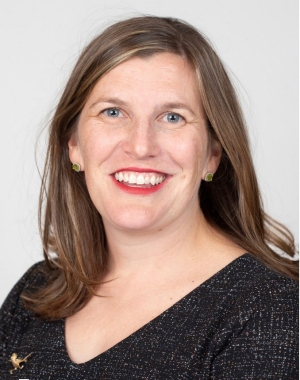
Julie Klingensmith
Julie Klingensmith (B.S. Ed. 2002, M.Ed. 2010) worked with her mathematics education team at Norman High to come up with a transition plan, and even received a little help from her JRCoE student intern.
“Our math department had weekly meetings to collaborate as a department and by course,” Klingensmith said. “We worked together to design lessons, make help videos, create Google forms and helped teach each other ways to use new technology. Students really liked it when we made help videos with our iPads; they could watch them on their own time. My student intern from OU helped me learn how to make those videos!
“It was nice knowing our district was focused on what was best for kids. We focused on relationships and enrichment, not grades.”
The Future
As of this writing, OU plans to have students return to campus this fall with a mixture of in-person and online classes that adhere to recommended safety guidelines. Administrators in the college are already working on a plan for Collings Hall that will allow faculty, staff and students to return in some capacity. While this has been a difficult transition for everyone involved, educators know best how to turn a tough situation into an experience from which we can all learn.
